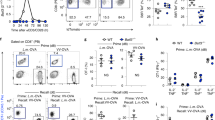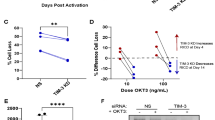Abstract
The ‘help’ provided by CD4+ T lymphocytes during the priming of CD8+ T lymphocytes confers a key feature of immune memory: the capacity for autonomous secondary expansion following re-encounter with antigen1,2,3,4. Once primed in the presence of CD4+ T cells, ‘helped’ CD8+ T cells acquire the ability to undergo a second round of clonal expansion upon restimulation in the absence of T-cell help. ‘Helpless’ CD8+ T cells that are primed in the absence of CD4+ T cells, in contrast, can mediate effector functions such as cytotoxicity and cytokine secretion upon restimulation, but do not undergo a second round of clonal expansion. These disparate responses have features of being ‘programmed’, that is, guided by signals that are transmitted to naive CD8+ T cells during priming, which encode specific fates for their clonal progeny. Here we explore the instructional programme that governs the secondary response of CD8+ T cells and find that helpless cells undergo death by activation-induced cell death upon secondary stimulation. This death is mediated by tumour-necrosis factor (TNF)-related apoptosis-inducing ligand (TRAIL). Regulation of Trail expression can therefore account for the role of CD4+ T cells in the generation of CD8+ T cell memory and represents a novel mechanism for controlling adaptive immune responses.
This is a preview of subscription content, access via your institution
Access options
Subscribe to this journal
Receive 51 print issues and online access
$199.00 per year
only $3.90 per issue
Buy this article
- Purchase on Springer Link
- Instant access to full article PDF
Prices may be subject to local taxes which are calculated during checkout




Similar content being viewed by others
References
Shedlock, D. J. & Shen, H. Requirement for CD4 T cell help in generating functional CD8 T cell memory. Science 300, 337–339 (2003)
Sun, J. C. & Bevan, M. J. Defective CD8 T cell memory following acute infection without CD4 T cell help. Science 300, 339–342 (2003)
Bourgeois, C., Rocha, B. & Tanchot, C. A role for CD40 expression on CD8 + T cells in the generation of CD8 + T cell memory. Science 297, 2060–2063 (2002)
Janssen, E. M. et al. CD4 + T cells are required for secondary expansion and memory in CD8 + T lymphocytes. Nature 421, 852–856 (2003)
Schoenberger, S. P. et al. Cross-priming of CTL responses in vivo does not require antigenic peptides in the endoplasmic reticulum of immunizing cells. J. Immunol. 161, 3808–3812 (1998)
Lyons, A. B. & Parish, C. R. Determination of lymphocyte division by flow cytometry. J. Immunol. Methods 171, 131–137 (1994)
Pitti, R. M. et al. Induction of apoptosis by Apo-2 ligand, a new member of the tumor necrosis factor cytokine family. J. Biol. Chem. 271, 12687–12690 (1996)
Wiley, S. R. et al. Identification and characterization of a new member of the TNF family that induces apoptosis. Immunity 3, 673–682 (1995)
Walczak, H. et al. TRAIL-R2: a novel apoptosis-mediating receptor for TRAIL. EMBO J. 16, 5386–5397 (1997)
Pan, G. et al. An antagonist decoy receptor and a death domain-containing receptor for TRAIL. Science 277, 815–818 (1997)
MacFarlane, M. et al. Identification and molecular cloning of two novel receptors for the cytotoxic ligand TRAIL. J. Biol. Chem. 272, 25417–25420 (1997)
Ehst, B. D., Ingulli, E. & Jenkins, M. K. Development of a novel transgenic mouse for the study of interactions between CD4 and CD8 T cells during graft rejection. Am. J. Transplant. 3, 1355–1362 (2003)
Droin, N. M., Pinkoski, M. J., Dejardin, E. & Green, D. R. Egr family members regulate nonlymphoid expression of Fas ligand, TRAIL, and tumor necrosis factor during immune responses. Mol. Cell. Biol. 23, 7638–7647 (2003)
Bhardwaj, A. & Aggarwal, B. B. Receptor-mediated choreography of life and death. J. Clin. Immunol. 23, 317–332 (2003)
Aggarwal, B. B. Signalling pathways of the TNF superfamily: a double-edged sword. Nature Rev. Immunol. 3, 745–756 (2003)
Smyth, M. J. et al. Nature's TRAIL–on a path to cancer immunotherapy. Immunity 18, 1–6 (2003)
Zhang, X. R. et al. Reciprocal expression of TRAIL and CD95L in Th1 and Th2 cells: role of apoptosis in T helper subset differentiation. Cell Death Differ. 10, 203–210 (2003)
Martinez-Lorenzo, M. J. et al. Involvement of APO2 ligand/TRAIL in activation-induced death of Jurkat and human peripheral blood T cells. Eur. J. Immunol. 28, 2714–2725 (1998)
Sun, J. C., Williams, M. A. & Bevan, M. J. CD4 + T cells are required for the maintenance, not programming, of memory CD8 + T cells after acute infection. Nature Immunol. 5, 927–933 (2004)
Cretney, E. et al. Increased susceptibility to tumor initiation and metastasis in TNF-related apoptosis-inducing ligand-deficient mice. J. Immunol. 168, 1356–1361 (2002)
Strasser, A., Harris, A. W. & Cory, S. bcl-2 transgene inhibits T cell death and perturbs thymic self-censorship. Cell 67, 889–899 (1991)
Grillot, D. A., Merino, R. & Nunez, G. Bcl-XL displays restricted distribution during T cell development and inhibits multiple forms of apoptosis but not clonal deletion in transgenic mice. J. Exp. Med. 182, 1973–1983 (1995)
Pascolo, S. et al. HLA-A2.1-restricted education and cytolytic activity of CD8(+ ) T lymphocytes from beta2 microglobulin (beta2m) HLA-A2.1 monochain transgenic H-2Db beta2m double knockout mice. J. Exp. Med. 185, 2043–2051 (1997)
Dialynas, D. P. et al. Characterization of the murine T cell surface molecule, designated L3T4, identified by monoclonal antibody GK1.5: similarity of L3T4 to the human Leu-3/T4 molecule. J. Immunol. 131, 2445–2451 (1983)
van Stipdonk, M. J., Lemmens, E. E. & Schoenberger, S. P. Naive CTLs require a single brief period of antigenic stimulation for clonal expansion and differentiation. Nature Immunol. 2, 423–429 (2001)
Pinkoski, M. J., Droin, N. M. & Green, D. R. Tumor necrosis factor alpha up-regulates non-lymphoid Fas-ligand following superantigen-induced peripheral lymphocyte activation. J. Biol. Chem. 277, 42380–42385 (2002)
Acknowledgements
We thank H. Grey for critical evaluation of the manuscript and S. Jameson for providing peptide/MHC tetramers. This work was supported in part by grants from the National Institutes of Health and the American Cancer Society and by a gift from the estate of Wilton N. Chamberlain. This is manuscript number 649 from the La Jolla Institute for Allergy and Immunology.
Author information
Authors and Affiliations
Corresponding authors
Ethics declarations
Competing interests
The authors declare that they have no competing financial interests.
Supplementary information
Supplementary Figure S1
Primary responses of helped and helpless E1B192-200-specific CD8+ T cells in mice genetically modified for various apoptosis related genes. This file shows the enumeration of primary E1B192-200-specific IFN-γ-producing CD8+ T cells for which secondary expansion is depicted in Figure 2b. (PDF 37 kb)
Supplementary Figure S2
Analysis of secondary expansion in vitro by OVA257-264/Kb tetramers. This file shows secondary expansion of helped and helpless CD8+ T cells from act-mOVA.bm1-immunized as analyzed using OVA257-264/Kb tetramers. (PDF 45 kb)
Supplementary Figure S3
TRAIL expression in LCMV-specific helpless CD8+ T cells. This file shows the induction of TRAIL mRNA expression by RT-PCR in CD8+ T cells isolated from LCMV-infected mice 14 days after infection that were sorted by flow cytometry using GP33-41/Db tetramers. (PDF 55 kb)
Rights and permissions
About this article
Cite this article
Janssen, E., Droin, N., Lemmens, E. et al. CD4+ T-cell help controls CD8+ T-cell memory via TRAIL-mediated activation-induced cell death. Nature 434, 88–93 (2005). https://doi.org/10.1038/nature03337
Received:
Accepted:
Issue Date:
DOI: https://doi.org/10.1038/nature03337
This article is cited by
-
Establishment of a novel NFAT-GFP reporter platform useful for the functional avidity maturation of HLA class II-restricted TCRs
Cancer Immunology, Immunotherapy (2023)
-
Dendritic cells in cancer immunology
Cellular & Molecular Immunology (2022)
-
T cell apoptosis characterizes severe Covid-19 disease
Cell Death & Differentiation (2022)
-
Rethinking peripheral T cell tolerance: checkpoints across a T cell’s journey
Nature Reviews Immunology (2021)
-
Interruption of MDM2 signaling augments MDM2-targeted T cell-based antitumor immunotherapy through antigen-presenting machinery
Cancer Immunology, Immunotherapy (2021)
Comments
By submitting a comment you agree to abide by our Terms and Community Guidelines. If you find something abusive or that does not comply with our terms or guidelines please flag it as inappropriate.



